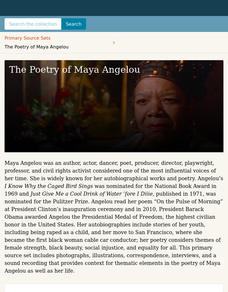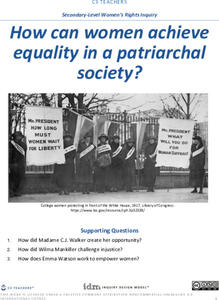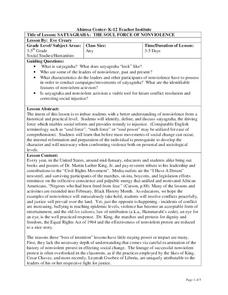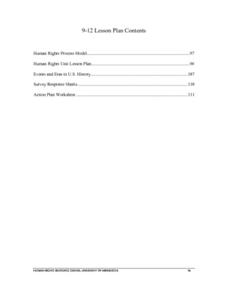Teaching Tolerance
Introducing 'The New Jim Crow'
When Jim Crow Laws ended, the intent behind them did not. Academics read "The New Jim Crow Laws" and an interview from the author to understand how racism has not ended, but rather changed over time. The lesson explains how prejudices in...
Teaching Tolerance
Racial Disparity in the Criminal Justice System
Explore the impact of the war on drugs in a thought-provoking lesson plan for high school academics. Young historians delve into the world of the criminal justice system and the racial disparity that occurs in the US. The resource...
Teaching Tolerance
In Our Own Words: A Story Book with a Purpose
Academics turn into storytellers in an engaging activity on activism. The activity focuses on promoting social change in local communities with stories. Young historians plan a storybook to target a specific audience and social issue and...
Digital Public Library of America
The Poetry of Maya Angelou
Maya Angelou's work reflects her passion for life, civil rights, and justice for all. A collection of 12 primary sources provide scholars with insight into this amazing woman. The set includes photographs, articles, recordings of...
Digital Public Library of America
Beloved by Toni Morrison
Any classroom study of Toni Morrison's Pulitzer Prize-winning novel Beloved requires careful planning and scaffolding. A primary source set that includes a video, illustrations, photos of artifacts, and a broadside of the Fugitive Slave...
National Woman's History Museum
Fannie Lou Hamer and Social Activism
Not all heroes wear capes. An impactful lesson focuses on the life and activism of Fannie Lou Hamer during the civil rights movement. Scholars read her speeches and other material, participate in group discussion, and complete a jigsaw...
Newseum
The Freedom to Make a Change
As part of a study of the First Amendment, young historians research instances when individuals or groups used the First Amendment to change the United State's laws or policies. Teams are each assigned a different case study. With the...
Penguin Books
A Teacher's Guide to the Signet Classic Edition of Charles Dickens's A Tale of Two Cities
It's not the best of guides nor the worst of guides, but time spent examining the guide to Charles Dickens's A Tale of Two Cities is certainly not wasted. The 17-page guide includes book-by-book synopses of the novel, before, during, and...
Learning for Justice
The Color of Law: Developing the White Middle Class
The final lesson in the "Color of Law" series explores the government's discriminatory economic policies. Young scholars watch videos, read primary source materials, and examine images to gather information. They discuss how what they...
Learning for Justice
The Color of Law: Winners and Losers in the Job Market
The second lesson in "The Color of Law" shows how government policies supported economic inequality. Scholars read additional excerpts and respond to text-dependent questions from "The Color of Law" text, examine primary source documents...
C3 Teachers
Women’s Rights: How Can Women Achieve Equality in a Patriarchal Society?
Women today may not have heard of Madame C.J. Walker or Wilma Mankiller, and a few may not be aware of Emma Watson's current role; however, they have certainly benefited from their efforts. Using questions supplied by this guided...
Curated OER
Satyagraha: The Soul Force of Nonvilence
Pupils discuss what satyagraha is understanding that it is the driving force which enables social reform. In this social science lesson, students try to internalize the principles of nonviolence on an individual level and then a global...
Curated OER
The Real Monopoly: America's Racial Wealth Divide
Learners explore America's racial wealth divide. In this Teaching Tolerance lesson, students play a "rigger" version of the game Monopoly and reflect on the game and economic injustice in the United States.
Facing History and Ourselves
What is Justice After Genocide?
Students explore the meaning and implications of genocide. In this human rights lesson plan, students investigate the Aremenian genocide that took place in Turkey and the subsequent trials of the leader of the genocide held by the...
Facing History and Ourselves
Emmett Till: Choosing to Remember
Mamie Till, the mother of Emmett Till and civil rights activist, believed that her son's murder was the last straw before public outrage over racial injustice spilled over into the Civil Rights Movement of the 20th century. A history...
Facing History and Ourselves
What Does It Mean to Belong?
After reading and analyzing The 'In' Group by Eve Shalen, sixth graders consider how the categorization of people results in exclusion, discrimination, and injustice.
Facing History and Ourselves
Continuing Lemkin's Legacy: What Can We Do to Prevent and Stop Genocide?
Young scholars investigate genocide. In this contemporary history instructional activity, high schoolers research Darfur advocacy organizations and present plans of action to stop the injustice in Darfur.
Curated OER
Religion in Social Change: What's God Got To Do With It?
Young scholars determine how religion influences social change. In this religion and social change lesson, students examine how the religious beliefs of Mohandas Gandhi and Martin Luther King, Jr. were inspirational as they worked to...
Curated OER
Charlotte's Web
Young scholars compare the differences in insects and spiders and design a worksheet that teaches the differences. Students record on chart
organizing the information about the pet, its food, habitat, exercise, and other ways to care...
Curated OER
Social Studies: Human Rights Then and Now
Students examine past and present human rights issues in U.S. history. In reflection journals, they document both justices and injustices perpetrated on groups and individuals. Finally, students implement an action plan designed to...
Curated OER
Stay in the Mix for Valentine's Day
Students understand the origins of Valentine's Day. For this injustices lesson, students read a story and recognize the injustices done on Valentine's Day. Students write about grade appropriate topics regarding injustices.
Curated OER
The Power of Autobiographical Writing
Students explore the concept of injustice. In this nonviolent resistance lesson, students discuss how autobiographical writing may be used to promote justice. Students read an excerpt from Gandhi's autobiography and determine how his...
Curated OER
Music And Violence: What Message is Music Promoting To Our Youth
Students analyze several pieces of music and videos to examine how popular musicians and their music affect us as individuals and as a society. The perception of society's ideals, hypocrisy in government, and injustice are explored.
Curated OER
Write for Change
Young scholars discuss and list injustices experienced in the novel "Hoot". They review the different ways letter writing was a part of the novel "Hoot". They choose one issue that is of concern to them and state their viewpoint on the...
Other popular searches
- Injustice Scenarios
- Immigration Social Injustice
- Social Injustice Poems
- Injustice Science
- Elie Wiesel Themes Injustice
- Social Injustice 5th Grade
- Soicla Injustice
- Causes and Social Injustice
- Injustice Mockingbird
- Injustice vs. Justice
- Injustice Poem
- Injustice Lesson Plan

























